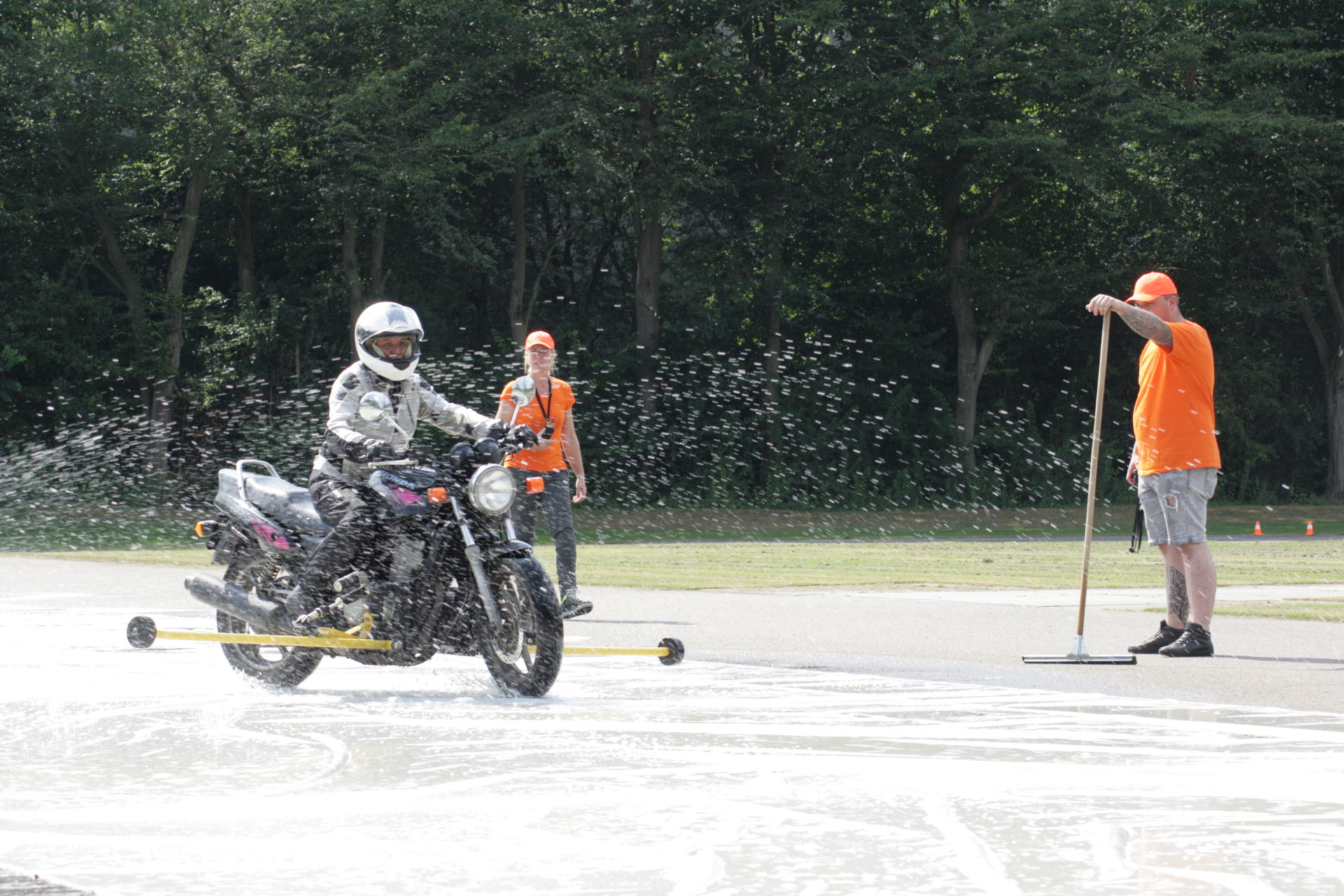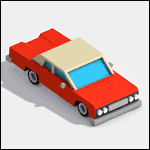|
Slavvy posted:This is all correct with one tiny anal caveat that no learner needs to care about : maximum traction on acceleration actually happens when the wheel is spinning slightly, usually 5-15% faster than road speed. This is moderately difficult to achieve with a powerful bike on a race track, it's very easy if your bike has good rider aids. I'm not big brained enough to articulate exactly why this is but it is 100% true, any drag racer will tell you the same thing. If you could hold a front tyre on the very edge of locking as it slides into the corner entry, you could slow down more, but it's extremely difficult master-level poo poo that I've never seen done IRL, only in high level racing and stuff. thank you that is quite insightful, i will think on this and start planning some exercises in a closed course so i can practice the proper things and work on not let the lizard take over
|
|
|
|

|
| # ? May 14, 2024 11:30 |
|
That makes me think of the first time I drove a car on the road and my brain forgot clutch plus brake plus turn and I did a clutch plus turn instead and scared my parents near to death. Thousands of hours driving a car later, Iíd never make that mistake now. Iíve got hundreds of hours on a bike at this point probably, but nowhere near the same muscle memory as I do in a car. I consider every ride practice, but havenít done a ride just to practice in a bit. This is a good reminder to make a little parking lot time. I can feel more things becoming automatic, but I donít want to be in that spot where I need to do three things and only remember two again.
|
|
|
|
I once had a session with a pro downhill rider who discussed weight transfer with regards to braking and how weight into the front wheel affected just how much you can haul up. He made us do drills in the dirt/gravel car park and had us ride at jogging pace and haul hard on the brakes at a neutral position. Result was rear locked up instantly and you slow down as your front fights for traction. He then demonstrated weight transfer by forcing his weight down into the suspension as he hauled on the brakes. Result was with more weight going into the tyres (front especially) he was able to stop a lot quicker and in control. When we all tried doing so it was wild just how much faster you could stop even on that lovely surface. Now obviously an MTB doesn't weigh much so you can influence it to greater effect and it wears big spiked tyres for traction but that has stuck with me ever since for how weight transfer works. He also talked about line choice and straight aired a 90 degree rock section people just gingerly picked their way down but that's another thing entirely  . Shaums March, fantastic guy and a really good rider. . Shaums March, fantastic guy and a really good rider.
|
|
|
|
Well, I don't quite understand the physics, I would have assumed a locked up front tyre would have the most possible stopping power and therefore weight transfer. Regardless, how do I train this properly? I have done my fair share of panic brake drills and repeat them every once in a while, but I mostly full-send it. Not like a lightswitch, I barely scratch the ABS threshold sometimes, but I certainly don't feather it in or anything. Are there some good exercises for this? It's obviously more important in low traction situations when you aren't going in a straight line and I'd love to get more of a feel for it.
|
|
|
|
No, the maximum amount of friction is reached with 10-15% of slip. Why that exact percentage? IDK, but the tire folks have long ago measured that. Probably when your tire is slipping too much, you're just putting kinetic energy into taking rubber off of your tire, rather than transfering it to your brake disks. When your brake is locked up, your brake disk is not dissipating any power. Only your tire is. Building up the brake force is something you do within a second. If the ABS doesn't come on, you're probably doing it right-ish, as long as you can get to a stop in 10 to 13 meters starting at 50km/h. If you're not meeting that (IIRC, it's a while ago, 12m at 50km/h is the cutoff for an emergency stop for your bike license test here), you're not braking hard enough to start to feel the effects of weight transfer i think. So yeah, maybe you're intuitively already doing it right? I did my lessons on a bike with old school ABS and it taught me the weight transfer thing very quickly. Slam on the brakes and it would start ABS'ing instantly and you'd overshoot by 2 meter or so. Do it properly, and by the time ABS intervened you'd almost be stopped. It is totally fine to brake until ABS intervenes, that's what (on a modern bike!) keeps you at that 10% slip level. But only as long as you've really reached the maximum amount of pressure on your front wheel. If you can't manage the ABS to come on, you might just be going too slowly and be stopped before you have built up enough brake force. As a side note, this is also pretty valid in cars, though a bit less influential. I was surprised when i stabbed the brakes in my car (no ABS) and locked up the tires instantly before feeling much deceleration. If you do it right, you'd be hanging in your seat belt. LimaBiker fucked around with this message at 07:43 on Jul 14, 2022 |
|
|
|
LimaBiker posted:No, the maximum amount of friction is reached with 10-15% of slip. Why that exact percentage? IDK, but the tire folks have long ago measured that. Probably when your tire is slipping too much, you're just putting kinetic energy into taking rubber off of your tire, rather than transfering it to your brake disks. Yeah I excelled at emergency braking during my license, I am not worried about straight line braking on good asphalt. But with what has been discussed, not overbraking the front so as to keep enough grip to not skid out sideways/lose control seems like something important I wanna tackle next and get some experience with. So far I mostly worry about the rear slipping at times, which it never does cause I probably have years of grip left under normal riding conditions, but it's what "seems" to be the next thing to happen. But with everything discussed (and a high side crash being much much worse than a lowsider) I feel like I'd want to get any practise and muscle memory I can get.
|
|
|
|
Honestly, that bit i don't know a lot about. I only know two things to pay attention to: under braking in a corner while leaned over, your bike will try to right itself up, and because your front fork gets 'shorter' your handling characteristics and line through the corner will change. You have to be prepared to correct for that. This is valid both for ABS and non ABS bikes. Some bikes with cornering ABS can sense this and try and fix it, but idk how well that works. Also, if you're leaned over, in a corner, and due to the braking you stop at some point, you gotta right up the bike at some point. Because leaned over + low speed = stumbling to keep the bike upright. You can safely try it out with normal/gentle braking. You won't randomly wipe out the front if you don't brake harder than you usually do when braking for a traffic light you see somewhere down the road. The rear is easier to lock up, again because of the weight transfer to the front. Doesn't mean 'don't touch the rear brake' but you gotta be aware and prepared for the rear to step out. Perhaps this won't make you feel how much traction you have before stuff goes very bad, but it will make you feel the changing behavior that braking in a corner gets you. You need to try everything out and learn how it feels in your butt. Can't really put some of those feelings into words, but when you know, you just know. LimaBiker fucked around with this message at 09:46 on Jul 14, 2022 |
|
|
|
LimaBiker posted:Honestly, that bit i don't know a lot about. I only know two things to pay attention to: under braking in a corner while leaned over, your bike will try to right itself up, and because your front fork gets 'shorter' your handling characteristics and line through the corner will change. You have to be prepared to correct for that. This is valid both for ABS and non ABS bikes. Some bikes with cornering ABS can sense this and try and fix it, but idk how well that works. Oh yeah I've run dry weather corner brake drills during courses before, we actually learned to use the self-righting behavior to our advantage. I'm really more interested in tipping my toes into low friction behavior.
|
|
|
|
 If you don't wanna risk your bike trying stuff out by yourself, get to a special slippery road training course. They have bikes with outriggers (either on springs or mounted so high that you won't use them until you're went too far) so you can lean over, but if the rear breaks away nothing will hit the tarmac except for the outrigger wheel. No idea if this is some weird thing only available in Yurp, i tried finding some english things but i can't seem to find the correct search words for it. https://www.youtube.com/watch?v=GE_SV0gU50M&t=107s Video of the low traction course. This specific one doesn't seem to offer much 'braking while cornering in low traction scenarios' stuff but still looks hella fun to try. I'm sure there's one course out there that includes trying out the outrigger bike on a circular skid pan/g force thing. LimaBiker fucked around with this message at 15:23 on Jul 14, 2022 |
|
|
|
So I've finally tried a gen3 SV650 - bro saw the light and bought one to replace his versys. IMO it's a very fun bike that would probably suit me fine and I'll be on the lookout for a good deal on one for me as well. No rush though, my little Honda is still a Good Bike and I still learn things on it.
|
|
|
|
LimaBiker posted:
Yeah this seems perfect but I haven't found any place that offers something similar nearby unfortunately. Might have to check if Germany has something like that and make it a trip.
|
|
|
|
Found a supermoto guy doing kart track trainings with the express purpose of sliding front and back, crashes are part of the course cost. I'm sold. Couldn't find anyone doing the training wheel stuff for anything but "see how low you can push yourself"
|
|
|
|
i dropped my bike in a somewhat similar way about a week ago. i was turning left and a car behind me honked (not _at_ me, i later discovered). i did the thing everyone says not to do and snatched the front brakes while in the middle of a turn and, what do you know, the bike slid out from under me. it didn't even feel like a decision. one moment i was turning and the next i was on the ground. intellectually i know not to go for the brakes in the middle of a turn but reflexes are basically impossible to override in those moments. savvy is right, the only way to overcome bad reflexes is to drill in good reflexes. i am fine, my gear is barely even scratched. the handlebars and one turn signal got bent, but i already replaced those. i honestly liked having an excuse to replace them. picking out parts and wrenching is hella fun, and these particular ones were already aftermarket so I was able to get something closer to stock. unrelated dumb question: i have been going by the tire pressure psi recommendations in the owner's manual. is that the right thing to do even if the tires are not the ones that came from the factory?
|
|
|
|
I just realized something from slavvys post in reply to my crash I think : when I found i was losing power and then eventually lost power and my engine locked up , I was in the middle of trying to downshift thinking something happened to the gear I was in , and I bet I let go of the clutch at the moment I was on the gravel So I think - again correct me if Iím wrong with a dead engine thatís in gear , if you let out the clutch your rear wheel is basically going into full lock Like a car would in gear I let go of the clutch and that was the end of it for me I should have kept the clutch in the entire time, obviously Also why does the beginner riders course not teach you what to do in case of a dead bike ? I donít remember them even touching on it aside from ďget to safetyĒ My lizard brain was over loaded and trying to do too much and forgot clutch is good, me no want let go clutch Now my second huge concern is deciding what type of wave I want to use The 2 fingers up , low side finger gun , or big wave above the head
|
|
|
|
MSPain posted:i dropped my bike in a somewhat similar way about a week ago. i was turning left and a car behind me honked (not _at_ me, i later discovered). i did the thing everyone says not to do and snatched the front brakes while in the middle of a turn and, what do you know, the bike slid out from under me. it didn't even feel like a decision. one moment i was turning and the next i was on the ground. intellectually i know not to go for the brakes in the middle of a turn but reflexes are basically impossible to override in those moments. savvy is right, the only way to overcome bad reflexes is to drill in good reflexes. Good that youíre safe and also got a lesson learned like I did ! Just from reading your post I will keep mentally repeating to myself to go easy on the front brake in a turn , gentle and progressive Hell I did it a week ago in the parking garage when a truck in front of me stopped mid turn around the corner. So I grabbed the front and almost tipped but caught it in time As for buying stuff I also am using this as an excuse to get new mirrors with integrator turn signals. Since I need 1 new mirror anyways and the right side fairing cracked where the OEM turn signal mounts So 2 birds 1 stone I figure
|
|
|
|
MSPain posted:i snatched the front brakes while in the middle of a turn and, what do you know, the bike slid out from under me. it didn't even feel like a decision. one moment i was turning and the next i was on the ground. intellectually i know not to go for the brakes in the middle of a turn You, in fact, can go to the brakes mid turn, and it is an important, potentially life-saving, skill to develop. What matters is a gentle initial application. As you build the pressure you remove lean, as both leaning and braking are using up what grip your tire has; less lean = more brakes. Additionally the suspension works better the more upright the bike is, allowing you to brake even more. A safe way to get a feel for your brakes is to just push your bike around, in neutral and turned off, and pull in (and release) the brake level as slowly and smoothly as possible. You'll be able to feel the correlation between how far you pull the lever and how much braking force is being applied. After that, find a safe space, eg a parking lot, and practice while riding. Then practice slowly releasing the lever after you've started to turn in.
|
|
|
|
Blue On Blue posted:I just realized something from slavvys post in reply to my crash Leaving the clutch engaged on a dead bike will slow the bike down via compression or "engine braking." However, when your speed really decreases, things will get kind of unpredictable, the bike will lurch and buck and the rear wheel will lock skid turn lock skid turn. So it's good to just disengage the clutch (lever to the bar) when you are in a situation in which you need to quickly come to a stop and get to the side of the road. Sufficient and skillful application of the front brake will kind of override whatever a rear wheel in gear with a dead engine is trying to do, but disengaging your clutch simultaneously with beginning your front braking is probably* the right thing to do. *I say probably because that's what I was taught, but having seen a bunch of chatter on this forum lately about weird stuff from MSF teachers, it's very possible this was not a great thing for me to be taught.
|
|
|
|
If you have any reason to doubt that your engine is still fine, you could pull in the clutch. A seized engine can lock up the rear wheel. An appropriate sitiation is loud bad engine sounds. Loss of oil pressure too. In general it won't seize within a few minutes, but still... Perhaps there is a catastrofic failure causing the loss of oil pressure. In almost all other cases stay in gear. Downshifting is not part of the emergency stop drill here, but you are encouraged to stay in gear with clutch engaged until you are almost at idle revs. If it is a rapid but not emergency stop, downshifting is mandatory on the exam over here. A stopped engine will just chirp the tire and then turn over if you are on the road and dump the clutch (that's what you do when bump starting). If it doesn't start you just have slightly more engine braking than normal. On gravel you will likely end up with a locked tire, not having enough traction to overcome the conpression.
|
|
|
MSPain posted:
Absolutely! The factory pressures, like the factory suspension and factory ergonomics, are specced to the worst case scenario. The leeway is quite big, the type and brand of tyre, the size of the wheel and the weight and dimensions of the bike all have an effect. What bike, what tyres? I can tell you what I'd run for me personally and if it's different to what you run you can try it and see what happens. Generally, too little pressure = squirming,wobbling, squishiness, rear tire breaks loose very early. Too much pressure = shaking, vibration, general harshness, feels like you've never got any grip or feel what the rubber is doing at all, traction loss is unpredictable as the tyres skip and skitter over every bump.
|
|
|
|
|
tu250x rear is an avon roadrider. front is a cheng shin which is actually stock, so the manual should be fine for that one. is it bad that they are mismatched? they both look pretty new to my eye MSPain fucked around with this message at 05:06 on Jul 15, 2022 |
|
|
|
They don't have to be exactly the same, but they should be at least somewhat similar in their characteristics. Also make sure they aren't too old: https://motofomo.com/tire-date-codes-dot/#:~:text=The%20tire%20date%20code%2C%20also,50%20for%20simpler%20mental%20arithmetic. Cheng Shin makes good bicycle tires, no idea if they're worth anything on a motorcycle.
|
|
|
MSPain posted:tu250x I would start by getting rid of both of those as they are pretty dismal. I'd run about 32psi rear, 30psi front if you're relatively light but yeesh, those really aren't great tires. If you've got some money it's well worth spending it on some decent rubber, it makes a tangible difference to the bike's feel and handling.
|
|
|
|
|
Slavvy posted:I would start by getting rid of both of those as they are pretty dismal. I'd run about 32psi rear, 30psi front if you're relatively light but yeesh, those really aren't great tires. If you've got some money it's well worth spending it on some decent rubber, it makes a tangible difference to the bike's feel and handling. Avon seems highly regarded as far as I could tell during my last tyre search? Lots of positive test results and such.
|
|
|
|
As long as we're picking brains for tire info... I have only one beef with the T120 so far and it comes about when cornering. The only bike I've spent time on in the twisties was a Suzuki GS500e, and on the Bonneville I struggle to take familiar turns at half the speeds I used to on the GS500. On faster turns (40mph+) I end up pushing exceptionally hard to not run wide; I can't really speak to traction or clearance (pegs do drag early) because this steering heaviness becomes my limiting factor. As I get more familiar with the bike and better about my lines the situation is improving, but I assume this bike will never be as "flickable" as the Suzuki. Is this something that different tires could improve slightly though? I've got stock tires which are Pirelli Phantom Sportscomps, 100/90-18 bias tire with tube in front, 150/70R17 radial in the rear. From what I've gathered people like to put 110/80 radials in the front with a tube for the spoked rim, but I also have developed a fairly low confidence in what people on other motorcycle forums think and do.
|
|
|
SEKCobra posted:Avon seems highly regarded as far as I could tell during my last tyre search? Lots of positive test results and such. Never seen an Avon I liked, I've only ever seen them on poo poo bikes as the cheapest option in a given size but they aren't common here at all. Remy Marathe posted:As long as we're picking brains for tire info... I have only one beef with the T120 so far and it comes about when cornering. The only bike I've spent time on in the twisties was a Suzuki GS500e, and on the Bonneville I struggle to take familiar turns at half the speeds I used to on the GS500. On faster turns (40mph+) I end up pushing exceptionally hard to not run wide; I can't really speak to traction or clearance (pegs do drag early) because this steering heaviness becomes my limiting factor. There will be a small improvement by changing tires, I don't rate the phantom particularly highly as it seems to be one of those place holder tires that get put on new bikes because they're cheap. But when it comes to arm effort, that's basically what it's like to go fast on a big bike, it's not office work. Make sure you're doing the fundamentals right too - it will steer much heavier and have less lean angle if you're on a shut throttle, it will steer heavy if the pressures are low or the tyres are squared off. You can try bumping the rear preload up a step which will at least make it roll a little faster. You can also try leaning off a bit. It's hard to tell if you have an actual problem or if they bike is totally normal and it's just lack of context; a gs500 is a much lighter, shorter bike with skinnier tyres, but neither of these are what I'd call normal or average handling bikes by modern standards.
|
|
|
|
|
Putting Pirelli Rosso 3 was an amazing upgrade on my lil MT3. Highly recommend, unless tire life is important then get the angel gts.
|
|
|
|
Slavvy posted:There will be a small improvement by changing tires, I don't rate the phantom particularly highly as it seems to be one of those place holder tires that get put on new bikes because they're cheap. But when it comes to arm effort, that's basically what it's like to go fast on a big bike, it's not office work. Make sure you're doing the fundamentals right too - it will steer much heavier and have less lean angle if you're on a shut throttle, it will steer heavy if the pressures are low or the tyres are squared off. Lack of context is my challenge too without much bike experience. I don't think there's anything fundamentally wrong with my T120; the rear tire was visibly squared off a bit by the PO's first 2000 miles but it's not looking as extreme anymore, I'm still debating doing a tire change early. My main takeaway here is probably "push harder" to a degree that would've tipped me over on the gs500. I'm curious what directions a GS500 is an outlier vs. modern bike handling, because I always assumed it was the poster child for an "average" street bike before specializations kick in so I calibrate a lot of what I read against it. I've assumed most street bikes beyond that beginner bike are more aggressively positioned and lean with less pressure, but maybe I've guessed wrong on the latter given how light it was.
|
|
|
|
If the rear tyre was visibly squared off it's hosed, you can't bring them back through voodoo somehow. Get new, matching tires and it'll make some amount of difference. If you can get angel GT or night dragon in your sizes do that, a v shaped profile will improve things. The gs500, for it's physical size and capacity: Is heavy Is top-heavy Is rear-heavy Has garbage suspension Has skinny tyres Has lazy geometry Has no power Has no brakes Has frame made of udon All this adds up to a bike that steers quite light but is also very slow to roll, very pitchy, very wobbly and generally discourages you from going faster than a certain pace. Your triumph by comparison has very heavy steering but is also very stable. So in my mind, you're accustomed to a bike that can be steered with your pinky but rapidly nopes out when you push past it's comfort zone. On a bike as long and heavy and low as your triumph (not to mention modern technology etc) you can heave it into the turn so fast that both tyres will start pumping up and down, the whole bike will shuffe laterally and you still won't even get close to crashing before you run out of road. It's literally impossible for you to ride off the edge of the tyre because that bike will always run out of ground clearance before it runs out of rubber. It's very difficult for you to fold the front or step out the rear because you have a cruiserish combination of lazy geometry and loads of mechanical traction. Just heave it in there. Modern normal bikes like say an sv, compared to a gs500, have heavier feeling steering but roll faster. You gotta realise there's three variables (actually more like ten but hey!) we're talking about on corner entry alone: how fast it rolls, how much leverage the bars give you, and how steep the fork is. Gs500: rolls slow, shallow fork, lots of leverage - light but slow steering Sv650: rolls fast, steeper fork, moderate leverage - moderately heavy but fast steering T120: rolls slow, steeper fork, low leverage - heavy but reasonably fast steering Slavvy fucked around with this message at 20:16 on Jul 16, 2022 |
|
|
|
|
Slavvy posted:excellent posting I think OP should try a SV
|
|
|
|
Yeah thanks for that effortpost, helps a ton. I'd happily try every bike I could get my hands on including an SV, but not being in the market I'd feel like a jerk showing up for test rides. I probably ride on the slow end, and don't yet appreciate how fast a good bike can safely turn. I always felt I was limited more by sight distance than suspension on the GS500. Replacing the stock front springs with progressives did take a lot of the bounce out of the front, and now I wonder if maybe I developed my overemphasis on accelerating through turns in order keep a squishy bike more stable.
|
|
|
|
If you're running wide and not going very fast the issue isn't to do with your bike, it's how you're setting up for and taking the corner. Make sure you're on the outside of your lane going into the corner and leave your turn-in later. Later turn-in means you'll be tighter on the exit. Brake in to the apex, gradually letting off pressure. Look for where the apex of your line is going to be; that's where you're going to be at maximum lean, so you can time your movements through the corner.
|
|
|
|
It's only the 40mph+ cornering I'm running into issues with, specifically turns where I fail to delay apex enough and then, where my penance would have traditionally been a hard lean and scraping peg, I'm just countersteering what I think is extremely hard but still not heeling over much. It sounds like I need to unlearn my idea of "extremely hard" and push way harder.
Remy Marathe fucked around with this message at 22:26 on Jul 16, 2022 |
|
|
^^^ reading the above post, I'd seriously suggest cranking another step of rear preload into it or taking out a click of rebound if available. Has it got any kind of fork adjustment?Remy Marathe posted:Yeah thanks for that effortpost, helps a ton. I'd happily try every bike I could get my hands on including an SV, but not being in the market I'd feel like a jerk showing up for test rides. The more garbage your bike, the more you have to brake early and upright, get on the throttle really early and keep it on the back wheel so it stays stable. Your triumph is much better and can cope with some amount of trail braking as well as not getting as upset over small bumps when you're 'floating' and not decisively on the brakes or throttle. But it also has bigger tires that demand more lean angle for a given corner speed. How this works out in practice is you have to lean both further and faster within the same distance traveled to be able to make the same corner at the same speed. So basically your GS let you make relatively small movements, leading to relatively low lean angle, but still go reasonably quick because the tyres are skinny. This means the GS was probably slightly faster in the middle of the corner. Otoh the triumph can brake much, much harder and accelerate both faster and more stably. This means that any small deficiency in the middle of the corner is more than made up for by how much later you can turn and brake, and how much quicker you leave when you start to roll on, provided you can take advantage. All of this takes more physical effort, more moxy, more precision because you have to move precisely but decisively in one smooth motion, instead of gradually and gently working your way into the lean over a relaxed period of time. Anecdotally, this is why it's very easy to embarrass crap riders on big bikes when you're on a small skinny bike and why I still own a cb125 TWINN as a quick and dirty yardstick to judge people I've not ridden with before. Crap riders tend to lack the skill and courage to use their big bike's strengths (braking, fast rate of roll, fat tyres with loads of lean), which leaves them with basically nothing except straight line speed. In the absence of a big straight, the advantage you have on a lovely small bike in the middle of the corner is devastating and 5-6 corners strung together in a row leaves you with an insurmountable advantage. Slavvy fucked around with this message at 22:35 on Jul 16, 2022 |
|
|
|
|
If anyone wants extra credit they should watch this video https://www.youtube.com/watch?v=dEYEn_fpv-4 Note how the big gixxers' powerful brakes and rapid acceleration mean jack poo poo when they're just constantly stuck in the middle phase of the corner, while the ugly quasimodo thing with it's skinny tyres and lovely air cooled lump just destroys them, because it has a fundamental geometric advantage through it's skinny tyres, is thus able to maintain a really high average speed and thus doesn't need to accelerate fast. The gixxers can't use their strengths, and those strengths are the only reason they've got big fat tyres to start with.
|
|
|
|
|
I would daily the Quasimoto.
|
|
|
|
|
|
|
numberoneposter posted:I would daily the Quasimoto. Hell, same E: 7 laps means 14 turns with a brief burst of acceleration between, and in this scenario shitbike is up against skilled riders who know exactly what they're doing. How many corners are there on your local fun road and how big are the straights between? How good are your local gixxer squids? How big of a bike can you actually use? Food for thought. Slavvy fucked around with this message at 23:03 on Jul 16, 2022 |
|
|
|
|
What is a safe way to practice these relatively high speed cornering concepts? I haven't found a parking lot big enough or twisty roads depopulated enough near me
|
|
|
MSPain posted:What is a safe way to practice these relatively high speed cornering concepts? I haven't found a parking lot big enough or twisty roads depopulated enough near me
|
|
|
|
|

|
| # ? May 14, 2024 11:30 |
|
Good plan
|
|
|





























